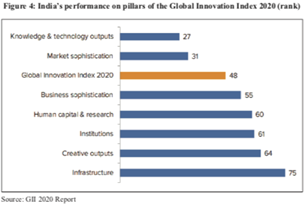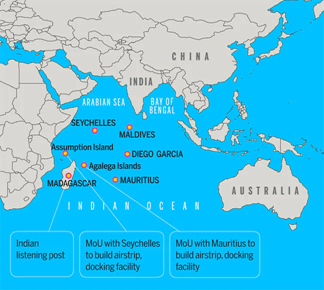Monday, 22nd February 2021
Survey to address data gap on migrant workers
In News
The lack of data on workers, which was evident during the COVID-19-induced lockdown in 2020, would be addressed by the five all-India labour surveys being conducted by the Labour Bureau.
Five surveys being undertaken by the Labour Bureau
● All-India Survey on Migrant workers
● All-India Survey on Domestic Workers
● All-India Survey on Employment Generated by Professionals
● All-India Survey on Employment Generated in Transport Sector
● All-India Quarterly Establishment based Employment Survey.
Need for the Migrant workers database
● Poor implementation of protections under the Inter-State Migrant Workmen Act, 1979 (ISMW Act) - The Act seeks to regulate the employment of inter-State migrants and their conditions of service. A report by the Standing Committee on Labour observed that registration of workers under the ISMW Act was low and implementation of protections outlined in the Act was poor.
● Lack of portability of benefits - Migrants registered to claim access to benefits at one location lose access upon migration to a different location, particularly under PDS. Ration cards required to access benefits under the PDS are issued by state governments and are not portable across states.
Recent government initiatives of mapping internal migration
● ASEEM Portal: The Ministry of Skill Development and Entrepreneurship (MSDE) has launched Atma Nirbhar Skilled Employee Employer Mapping (ASEEM) portal to help skilled people find sustainable livelihood opportunities. Database of labour migrants in Indian states and overseas citizens, who returned to India under the Vande Bharat Mission and filled SWADES Skill Card, has been integrated with the ASEEM portal.
● National Migrant Information System: The National Disaster Management Authority (NDMA) has developed an online dashboard called National Migrant Information System (NMIS). The online portal (NMIS) would maintain a central repository of migrant workers and help in speedy inter-state communication to facilitate the smooth movement of migrant workers to their native places.
CBDT may take a look again at equalisation levy
In News
The Central Board of Direct Taxes (CBDT) may relook at the ‘equalisation levy’ for purchases where Indian businesses use overseas ecommerce platforms to sell goods and services to Indian consumers.
Equalisation levy – A Brief Background
• Taxation laws have been struggling to keep pace with changes with digitalisations. This has resulted in many transactions completely escaping the tax net.
• In this backdrop, OECD and the G-20 group initiated the Base Erosion and Profit Shifting (BEPS) project in 2015 to address the taxation issues of digital economy. The outcome was BEPS Action Plan 1, which proposed three interim options.
o Significant economic presence;
o Withholding tax on digital transactions; and
o Equalization levy
• India in this respect, introduced equalization levy (EL 1.0) in 2016 at 6% on payments received by a non-resident service provider from an Indian resident (carrying on business or profession) in respect of
o Online advertising,
o Provision of online advertising space and related services.
Equalization levy (EL 2.0)
• Finance Act 2020 has further expanded the scope of equalization levy to non-resident e-commerce operators by introducing a new levy of 2%(EL 2.0).
• While EL1.0 was limited to B2B transactions and compliance was required to be carried out by the payer, in case of EL2.0, both B2B and B2C transactions are covered and compliances are to be carried out by the non-resident e-commerce operator.
Issues with New equalization levy
• There is ambiguity as regards its scope and there are numerous interpretational issues leading to practical challenges in compliance.
• There are time and cost challenges in building or modifying the IT infrastructure required to track transactions.
• At present, the language of the law or the amendments proposed in the Finance Bill, 2021 makes no exception or offers a carve-out to avoid double taxation.
Draft "Humans in Space Policy for India - 2021"
In News
The Department of Space has now put up for public consultation the draft “Humans in Space Policy for India — 2021” and guidelines and procedures for its implementation.
Humans in Space policy 2021
• Policy principle: “It aims for sustained human presence in space as an instrument for development, innovation and foster collaborations in alignment with national interests.”
• Authorisation & Execution:DoS/lSRO with a mandate to carry out space activities in India is tasked with execution of activities of Indian human space programme.
Guidelines
Department of Space shall:
• Demonstrate human space flight capability leveraging the expertise of ISRO, national research institutions, academia, industry and other organisations.
• Define long-term road map for sustained human presence in low earth orbit and undertaking exploration missions beyond low earth orbit.
• Identify and develop necessary technologies for enabling sustained presence of humans.
• Constitute a suitable mechanism to enable participation of various national stakeholders in Indian human space programme.
• Define and develop a comprehensive collaborative framework for scientific research.
• Foster International cooperation and evolve collaborative programs of mutual interest.
• Strive for human resource development, and encourage entrepreneurship.
Special Series – Budget, Survey and Finance Commission
Topic 15 - Innovation: Trending Up but Needs Thrust, Especially from the Private Sector
Context
Economic Survey 2021 has highlighted that India must give a significant thrust to innovation if it aims to become the third-largest economy in the world.
Why Innovation Matters?
In economic terms, innovation describes the development and application of ideas and technologies that improve goods and services or make their production more efficient. From the society’s perspective, the fundamental outcomes of innovation are
· Economic growth: Innovation is to come up with new ideas and technologies that increase productivity and generate greater output with the same input.
· Increased well-being and communication: New digital technologies and innovative solutions create huge opportunities to fight sickness, poverty and hunger in the poorest regions of the world.
· Environmental sustainability: Sustainability and environmental issues, such as climate change, are challenges that require a lot of work and innovative solutions now and in the future.

As per the Economic Survey
· Survey shows the positive correlation between past innovation performance with increase in GDP per capita in PPP.
· An increase of 10 per cent in R&D investment has been associated with productivity gains ranging from 1.1 per cent to 1.4 per cent.
India’s performance on Innovation
· India ranks 48 amongst 131 countries in terms of its innovation performance as measured using the Global Innovation Index (GII) 2020.
· India is an innovation outlier in terms of its level of development (per capita GDP in PPP terms).
· India is a negative outlier in terms of its GDP, i.e. India seems to be underperforming in innovation w.r.t. the size of its GDP.
R&D Expenditure in India
· India’s gross domestic expenditure on R&D (GERD) as per cent of GDP is 0.7% is much below w.r.t developed countries which contribute over 2% of GDP.
· In India, the Government contributes 56 % of GERD while India’s business sector contributes a much smaller per cent to total GERD (about 37 %) than the business sector in all the other large economies such as China, US, Japan and UK (68 % on average).
· India has amongst the lowest number of R&D manpower as compared to other top ten economies.
· India ranks much below expectation for their level of equity market development in the overall GII. Equity market development facilitates greater high-technology innovation.
India’s Performance on Patents and Trademarks
· The total number of patents filed in India has risen steeply, mainly on account of increase in patent applications filed by non-residents. While patent applications filed by residents have increased steadily, they have risen at a much lower rate than patent applications by non-residents.
· Unlike patents, the total number of trademark applications filed in India has risen steeply mainly on account of increase in trademark applications filed by residents.
Policy Implications
· India needs boosting gross expenditure on R&D from 0.7 per cent of GDP currently, to at least to the over two per cent. It also involves significantly scaling up R&D personnel and researchers in the country, especially in the private sector.
· Given the low level of contribution to GERD by the business sector despite the generous tax incentives regime prevailing, businesses in India must focus on innovation to remain competitive in the new economy.
· For India to become an innovation leader, its residents’ share in total patent applications filed in the country must rise from the current level of 36 per cent.
· For innovation to flourish, ideas must be funded and taken to market. This needs a funding-financing ecosystem.
Steps Taken
· Companies have been allowed a weighted deduction of 100 per cent of expenditure w.r.t. scientific research on in-house R&D facility.
· The Startup India campaign assumes greater importance in the context of enhancing private participation in innovation in India.
· Department of S&T has launched a NIDHI program (National Initiative for Developing and Harnessing Innovations) under which programmes for setting up of incubators, seed fund, accelerators and 'Proof of concept' grant for innovators and entrepreneurs have been launched.
· To boost entrepreneurial spirit in India, the Atal Innovation Mission (AIM), a flagship initiative of NITI Aayog, is supporting two programs for setting up and scaling up of incubation centres.
As per the economic survey, India is able to effectively translate investments in innovation inputs to produce a higher level of innovation outputs. This implies that India stands to gain more from its investments into innovation than many other countries.
Model Question - Global Innnovation index 2020 shows that India seems to be underperforming in innovation w.r.t. the size of its GDP. Explain. Highlight steps taken by government to support innovation in India and suggest further steps.
Quad meet stresses on rules-based world order, respect for territorial integrity
In News
The first ministerial meeting of the Quad since the Biden administration assumed office took place.
Highlights of the Quad ministerial meeting
● Commitment to upholding a rules-based international order - Underpinned by respect for territorial integrity and sovereignty, rule of law, transparency, freedom of navigation in the international seas and peaceful resolution of dispute.
● ASEAN as an integral part of Indo-Pacific construct - In an effort to expand the concept and framework of Indo-Pacific, the Quad countries also discussed the role of ASEAN in the initiative.
● Concern expressed over the military coup in Myanmar - The US, along with the rest of the Quad partners, also highlighted the need to restore the democratically elected government in Myanmar, and the priority of strengthening democratic resilience in the broader region.
○ The Indian statement on Myanmar adopted a more cautious approach and reiterated the need of upholding the rule of law and the democratic transition in the country.
|
About Quad ● The Quadrilateral Security Dialogue is an informal strategic forum between the United States, Japan, Australia and India that is maintained by semi-regular summits, information exchanges and military drills between member countries. ● The Quad members have a common vision for a free, open and inclusive Indo-Pacific region, with clear support for ASEAN cohesion and centrality. |
Opportunities for India under Quad arrangement
● Countering Chinese Influence in the Indian Ocean - China depends heavily on the Indian Ocean routes with its various chokepoints for its trade. The Quad provides an important opportunity for India to undertake coalition building, rule setting and other forms of strategic exploration in the maritime sphere.
● Enhancing India’s role as a Net Security Provider - Being among the largest military powers in the Indian Ocean, Quad provides an important means for India to enhance security cooperation and strategic engagements.
● Ensuring collective action for humanitarian assistance - India can build around collective action in humanitarian assistance and disaster relief, monitoring shipping for search and rescue or anti-piracy operations, infrastructure assistance to climatically vulnerable states, connectivity initiatives and similar activities. In the recent Quad meet, the ministers discussed efforts to combat the Covid-19 pandemic, including vaccination programmes, and agreed to cooperate on enhancing access to affordable vaccines, medicines and medical equipment.
Visva-Bharati University
· The university was set up by Nobel laureate Rabindranath Tagore in 1921 at Santiniketan, West Bengal. Visva-Bharati, means the communion of the world with India.
· The institution was given the status of a central university in 1951 by an act of the Parliament.
· It’s Uniqueness-
o It was a conscious repudiation of the system introduced in India by the British rulers and Rabindranath Tagore initially sought to realize the intrinsic values of the ancient education in India.
o Classes were held in open air in the shade of trees where man and nature entered into an immediate harmonious relationship.
o Teachers and students shared the single integral socio-cultural life.
Hyderabad wins global ‘Tree City’ status
· It has been chosen as one among the ‘Tree Cities of the World’ by the Arbor Day Foundation jointly with the Food and Agriculture Organisation.
· Itis the only city in the country to have been selected as a response to its commitment to growing and maintaining urban forestry.
· This makes the city stand alongside 120 cities from 23 countries, including developed nations such as USA, UK, Canada, Australia etc.
· The city was evaluated based on the five standards:
o Establish Responsibility
o Set the Rules
o Know What You Have
o Allocate the Resources and
o Celebrate the Achievements
The blank pages in India’s online learning experience – The Hindu
Essence- The article talks about the adverse impacts of COVID-19 on the education sector especially girls, the shortcomings of government run schools in the offline mode as well as difficulty in coping up with online teaching methods for both the teachers and the students.
The article critically analyses the need for assessment of the gaps in the technology, infrastructure, accessibility, the urban and rural divide and impacts on other dimensions as well and the steps from the side of the government that con help in improving the situation now when the schools are starting to reopen. It sights the case study of Rajasthan- the grim situation and some positive findings at the same time.
Why you should read this article?
· The article gives a comprehensive understanding of pre and post COVID 19 lockdown scenario in the field of education.
· The efforts during the lockdown, the government initiatives, the success of these efforts and the shortcomings /gaps.
· The article can be used in sociological perspective (education, girls’ education, rural-urban divide, role of govt), essay examples or case study.
India-Saudi security ties getting stronger - ORF
Essence- Editorial is providing account of recent changes in India - Saudi relationship from energy security centric to accommodating interests in defense & overall security matrix. India - Saudi Arab’s upcoming joint military & naval exercises are going to further cement ties & enhance cross operability. From Riyadh declaration, then Indian PM Manmohan Singh’s visit to the Kingdom in 2010 to PM Narendra Modi’s two trips to Saudi Arabia, first in 2016 and then in 2019, and the visit of Saudi Crown Prince Mohammad bin Salman to India in 2019, along with Defense ministry’s engagement during this period has provided dynamism in relations.
Why you should read this article?
· To know the factors which are bringing dynamism in India - Saudi relationship.
· Article is providing information on initiatives like Joint Committee on Defense Cooperation (JCDC), Indian ships undertaking a number of goodwill visits to Saudi ports, MoU between Saudi General Authority of Military Industries and India’s Department of Defense Production.
· To understand impact of Saudi’s understanding of India’s approach and actions in Jammu and Kashmir.
Link - https://www.orfonline.org/research/india-saudi-security-ties-getting-stronger/
India needs to focus on digital infrastructure – Financial Express
Essence- India can easily expand its role in the growing global market for digital information-technology services, such as big data and analytics, digital legacy modernisation, climate change agenda, and the IoT by scaling up investments in human and physical digital infrastructure, and increased collaboration with local and global entrepreneurs. In this context the article analyses spatial and technology trends as well as the challenges and opportunities offered by digital transformation.
Why should you read this article?
· To have a glimpse of Digital Transformation and its impact on development landscape.
· Note down a few data points on technological entrepreneurship.
· Understand how Digital technology has begun to change the drivers of structural transformation and economic growth and enabled developing countries to catch-up, grow faster, quicker, better, and smarter.
· Get to know the impact of technology on economic and social development in India- Related Spatial and Technology trends. One can avoid reading technical details.
· Analyse challenges and opportunities in India’s digital transformation.
Link - https://www.financialexpress.com/opinion/india-needs-to-focus-on-digital-infrastructure/2199237/
Arogyakeralam Palliative Care Project: Ensuring care and support for the chronically Ill and inform in Kerala
In News
The government is likely to introduce Cryptocurrency and Regulation of Official Digital Currency Bill 2021 in the ongoing Budget Session of the Parliament.
Contours of the proposed bill
- It will create a facilitative framework for creation of the official digital currency to be issued by the RBI.
- It will put a complete ban on investment in cryptocurrencies and people, traders, exchanges, and other financial systems' participants will not be permitted to deal in cryptocurrencies.
- Cryptocurrency investors will be given a transition period of three-to-six months after the implementation of the new law to liquidate their investments.
- It will allow for certain exceptions to promote the underlying technology of cryptocurrency and its uses.
Need for such a bill
- As per the official estimates, around 7 million Indians hold cryptocurrencies worth more than $1 billion. This is vast unregulated financial sector till now.
- Without own official virtual currency, private coins or another country’s virtual cash might fill the vacuum leading to loss of monetary sovereignty.
If private digital currencies are allowed to dominate the ecosystem, there is more than a slight chance that these could eventually replace
Share the article
Get Latest Updates on Offers, Event dates, and free Mentorship sessions.

Get in touch with our Expert Academic Counsellors 👋
FAQs
UPSC Daily Current Affairs focuses on learning current events on a daily basis. An aspirant needs to study regular and updated information about current events, news, and relevant topics that are important for UPSC aspirants. It covers national and international affairs, government policies, socio-economic issues, science and technology advancements, and more.
UPSC Daily Current Affairs provides aspirants with a concise and comprehensive overview of the latest happenings and developments across various fields. It helps aspirants stay updated with current affairs and provides them with valuable insights and analysis, which are essential for answering questions in the UPSC examinations. It enhances their knowledge, analytical skills, and ability to connect current affairs with the UPSC syllabus.
UPSC Daily Current Affairs covers a wide range of topics, including politics, economics, science and technology, environment, social issues, governance, international relations, and more. It offers news summaries, in-depth analyses, editorials, opinion pieces, and relevant study materials. It also provides practice questions and quizzes to help aspirants test their understanding of current affairs.
Edukemy's UPSC Daily Current Affairs can be accessed through:
- UPSC Daily Current Affairs can be accessed through Current Affairs tab at the top of the Main Page of Edukemy.
- Edukemy Mobile app: The Daily Current Affairs can also be access through Edukemy Mobile App.
- Social media: Follow Edukemy’s official social media accounts or pages that provide UPSC Daily Current Affairs updates, including Facebook, Twitter, or Telegram channels.





